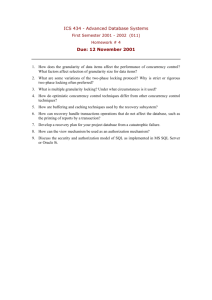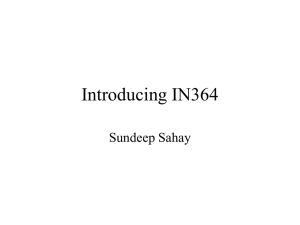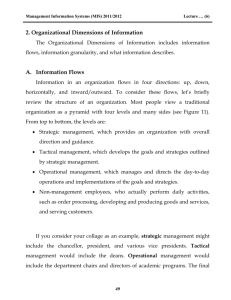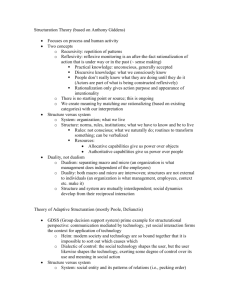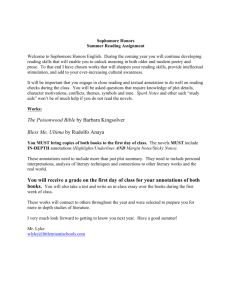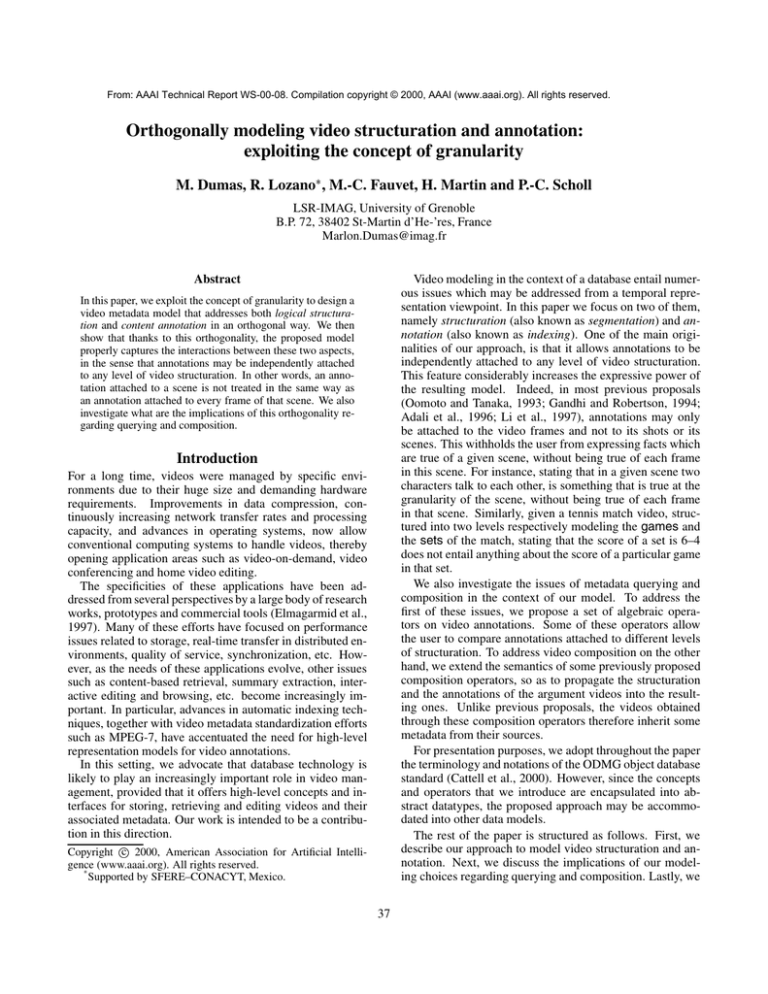
From: AAAI Technical Report WS-00-08. Compilation copyright © 2000, AAAI (www.aaai.org). All rights reserved.
Orthogonally modeling video structuration and annotation:
exploiting the concept of granularity
M. Dumas, R. Lozano , M.-C. Fauvet, H. Martin and P.-C. Scholl
LSR-IMAG, University of Grenoble
B.P. 72, 38402 St-Martin d’He-’res, France
Marlon.Dumas@imag.fr
Abstract
Video modeling in the context of a database entail numerous issues which may be addressed from a temporal representation viewpoint. In this paper we focus on two of them,
namely structuration (also known as segmentation) and annotation (also known as indexing). One of the main originalities of our approach, is that it allows annotations to be
independently attached to any level of video structuration.
This feature considerably increases the expressive power of
the resulting model. Indeed, in most previous proposals
(Oomoto and Tanaka, 1993; Gandhi and Robertson, 1994;
Adali et al., 1996; Li et al., 1997), annotations may only
be attached to the video frames and not to its shots or its
scenes. This withholds the user from expressing facts which
are true of a given scene, without being true of each frame
in this scene. For instance, stating that in a given scene two
characters talk to each other, is something that is true at the
granularity of the scene, without being true of each frame
in that scene. Similarly, given a tennis match video, structured into two levels respectively modeling the games and
the sets of the match, stating that the score of a set is 6–4
does not entail anything about the score of a particular game
in that set.
We also investigate the issues of metadata querying and
composition in the context of our model. To address the
first of these issues, we propose a set of algebraic operators on video annotations. Some of these operators allow
the user to compare annotations attached to different levels
of structuration. To address video composition on the other
hand, we extend the semantics of some previously proposed
composition operators, so as to propagate the structuration
and the annotations of the argument videos into the resulting ones. Unlike previous proposals, the videos obtained
through these composition operators therefore inherit some
metadata from their sources.
For presentation purposes, we adopt throughout the paper
the terminology and notations of the ODMG object database
standard (Cattell et al., 2000). However, since the concepts
and operators that we introduce are encapsulated into abstract datatypes, the proposed approach may be accommodated into other data models.
The rest of the paper is structured as follows. First, we
describe our approach to model video structuration and annotation. Next, we discuss the implications of our modeling choices regarding querying and composition. Lastly, we
In this paper, we exploit the concept of granularity to design a
video metadata model that addresses both logical structuration and content annotation in an orthogonal way. We then
show that thanks to this orthogonality, the proposed model
properly captures the interactions between these two aspects,
in the sense that annotations may be independently attached
to any level of video structuration. In other words, an annotation attached to a scene is not treated in the same way as
an annotation attached to every frame of that scene. We also
investigate what are the implications of this orthogonality regarding querying and composition.
Introduction
For a long time, videos were managed by specific environments due to their huge size and demanding hardware
requirements. Improvements in data compression, continuously increasing network transfer rates and processing
capacity, and advances in operating systems, now allow
conventional computing systems to handle videos, thereby
opening application areas such as video-on-demand, video
conferencing and home video editing.
The specificities of these applications have been addressed from several perspectives by a large body of research
works, prototypes and commercial tools (Elmagarmid et al.,
1997). Many of these efforts have focused on performance
issues related to storage, real-time transfer in distributed environments, quality of service, synchronization, etc. However, as the needs of these applications evolve, other issues
such as content-based retrieval, summary extraction, interactive editing and browsing, etc. become increasingly important. In particular, advances in automatic indexing techniques, together with video metadata standardization efforts
such as MPEG-7, have accentuated the need for high-level
representation models for video annotations.
In this setting, we advocate that database technology is
likely to play an increasingly important role in video management, provided that it offers high-level concepts and interfaces for storing, retrieving and editing videos and their
associated metadata. Our work is intended to be a contribution in this direction.
Copyright c 2000, American Association for Artificial Intelligence (www.aaai.org). All rights reserved.
*
Supported by SFERE–CONACYT, Mexico.
37
8g1 2 G1 G1,G2 (g1 )
G2 such that g1 g2
compare our proposal with respect to previous ones and provide some concluding remarks.
=
the unique g2
2
Any level of structuration of a video is naturally modeled
by a granularity over its time-line. Indeed, the set of shots
of a video may be seen as a set of disjoint intervals of timemarks covering the whole time-line of the video. Notice
that it is also possible to view the set of frames as a “degenerated” partitioning of a video time-line, in which each
partition is composed of a single time-mark. The advantage
of this modeling is that the notion of frame is seen as a structuration level of a video in the same way as shots or scenes.
This allows to attach annotations to shots or scenes in the
same way as they are attached to frames, as detailed in the
next section.
The following ODMG interfaces show how the concept
of granularity can be used to model a classical structuration
schema, in which videos are decomposed into sequences,
scenes and shots.
Video structuration
Video structuration is the process of grouping the frames of
a video according to their semantical correlations. For instance, a video is usually structured into shots, scenes, and
video sequences.
The structure of a video is analogue to the table of contents of a text document. As such, it can be used as a guide
for browsing, as the entry point for building video abstracts,
or as a mean to retrieve the context of a particular piece of
video.
There is a strong similarity between the structuration of
a video and the structuration of time in calendars. Accordingly, we propose a video structuration model based
on the concept of granularity. This concept has been extensively studied in several contexts such as temporal reasoning in artificial intelligence (Hobbs, 1985), and temporal
databases (Wang et al., 1995). The definition of granularity
that we adopt is a generalization of the one developed in this
latter work.
It is important to note that in this work, the concept of
granularity is merely used to model a hierarchical structuration, and not as an absolute temporal metric system. Indeed,
when time is structured into “regular” granularities such as
minutes and hours, these granularities may then be used to
express distances between time points.
The basic concept of the video data model that we consider is that of time-line. At an abstract level, a time-line TL
is a pair (D, <TL ), made up of a finite set of time-marks D,
and a binary relation <TL over this set defining a total linear
order.
Time-lines model independent time-coordinate systems,
with respect to which data and meta-data may be temporally
anchored. Each video has its own time-line, which captures
the temporal relations between its elementary components
(i.e. its frames).
A granularity over a time-line TL is defined as a partition
of TL into convex sets: each of these convex sets is then seen
as an atomic granule and every time-mark of the time-line is
approximated by the granule which contains it. A granularity is intrinsically attached to a unique time-line. The function that maps a granularity into a time-line is subsequently
denoted TimeLine. Thus, the expression TimeLine(G) denotes the time-line that granularity G partitions.
A hierarchical structure is defined over the set of granularities of a time-line through the definition of the finer-than
relation. A granularity G1 is finer-than another granularity G2 (G1 G2) if TL(G1) = TL(G2), and if a mapping
can be established between each granule of G1 and a set of
consecutive granules of G2
Given two granularities G1 and G2 such that G1 G2,
two mapping functions are defined: one for expanding a
granule of G2 into a set of granules of G1 (noted G2,G1 ),
and the other for approximating a granule of G1 by a granule of G2 (noted G1,G2 ).
f
interface TimeLine; /* not detailed here */
interface Granularity
TimeLine TimeLine();
bool finerThan(Granularity other);
g
f
interface Video
attribute TimeLine VTL;
attribute Granularity sequences;
attribute Granularity scenes;
attribute Granularity shots;
attribute Granularity frames;
/* Other attributes are described in the next section. */
g
For a given object V whose class implements the above
Video interface, the following constraints apply:
V.frames = MinGranularity(V.VTL), where MinGranularity denotes the function retrieving the finest granularity
of a time-line (i.e. the granularity whose granules are all
singletons). Such granularity is usually called the chronon
of a time-line in the temporal database literature (Tansel
et al., 1993).
TimeLine(V.sequences) = TimeLine(V.scenes) =
TimeLine(V.shots) = V.VTL
V.shots V.scenes V.sequences
The above Video interface may be specialized through
inheritance, so as to handle situations where other structuration levels are needed. For instance, in the context of
a video about a tennis match, structuration levels such as
point, game and set may be introduced.
Notice that two structuration levels within a single video
are not necessarily comparable with respect to the “finer
than” relation. For instance, consider a video about a tennis match possessing two structuration levels, namely point
and shot. If a granule of the shot granularity overlaps two
granules of the point granularity (without containing them
completely), then neither point shot, nor shot point
hold.
Video annotation
Given the current state of image processing technology, it
is not reasonable in the general case, to dynamically extract
8g2 2 G2 G2,G1 (g2 ) = fg1 2 G1 j g1 g2 g
38
semantical information from a video during query evaluation over a video database. Instead, in order to formulate
content-based queries over videos, their semantical content
must be previously described as annotations.
Annotations are generally stored separately from the
“raw” video data. This approach is quite natural, since annotations are normally only needed during video querying1,
while access to raw video data is only required during video
playing. In addition, this approach allows to share the “raw”
video data among several “virtual” videos, without necessarily sharing all the corresponding annotations (Lozano and
Martin, 1998).
Our approach to video annotation is based upon the concepts of instant and sequence.
An instant is as an approximation of a connected region of
a time-line by a granule. It is represented by a pair made up
of a natural number (the position of the denoted granule) and
a granularity. There is a subtle difference between an instant
and a granule: a granule is simply a set of time-marks, while
an instant is a reference to a granule, not the set of timemarks on itself. In particular, stating that a fact is true at an
instant (representing for instants a particular scene) does not
means that this information holds at each time-mark contained in the granule referenced by this instant.
A sequence is abstractly defined as a mapping from a set
of instants defined over a single granularity, to a set of objects sharing a common structure. An example of a sequence
is:
s1
s2
s3
s6
s7
s8
sequences has its own granularity, and it groups all the annotations attached to a given level of structuration, as depicted
in figure 1.
The following ODMG interface (which completes the one
given previously) summarizes the above discussion.
f
interface Video
/* attributes described in the previous section go here */
attribute Sequence Object sequencesAnnotations;
attribute Sequence Object scenesAnnotations;
attribute Sequence Object shotsAnnotations;
attribute Sequence Object framesAnnotations;
g
<
<
<
<
>
>
>
>
For a given object V whose class implements the above
interface, the following constraints apply:
Granularity(V.sequencesAnnotations)
=
V.sequences, where Granularity(SQ) stands for
the granularity of the domain of sequence SQ.
Granularity(V.scenesAnnotations) = V.scenes
Granularity(V.shotsAnnotations) = V.shots
Granularity(V.framesAnnotations) = V.frames
As stated before, the above interface is not intended to
be used “as is”. Instead, the user may specialize it to account for particular kinds of videos. For example, consider a
database managing a collection of movies identified by their
title. The frames of each movie are annotated with the names
of the actors appearing on them, while the scenes are annotated with the location where they take place. The following
specification captures this situation, by introducing a class
Movie which implements the interface Video. Notice that
the attribute framesAnnotations “inherited” from this interface, is specialized to account for the structure of the annotations managed in this context. A similar remark applies
to scenesAnnotations.
! h main character: “Linda”, main action: cook i
! h main character: “Linda”, main action: cook i
! h main character: “Linda”, main action: cook i
! h main character: “Joe”, main action: eat i
! h main character: “Joe”, main action: eat i
! h main character: “Joe”, main action: eat i
Where f s1, s2, s3, s6, s7, s8 g denote instants at
the same granularity (e.g. a set of scenes of a video), and
h att name: value, att name: value i denotes an object.
f
class Movie : Video (extent TheMovies, key title)
attribute string title;
attribute sequence Location scenesAnnotations;
attribute sequence Set string
framesAnnotations;
g
The above concepts are embedded into two ADTs respectively named Instant and Sequence. This latter is parameterized by a type modeling the set of possible values taken
by this sequence at a given instant. In the sequel, we will
use the notation Sequence<T> to denote the instantiation
of the type Sequence with type T.
Since sequences are modeled as instances of an ADT, the
user does not need to worry about the internal representation
of a sequence in order to reason about them. For instance,
the above sequence could be internally represented in the
following way :
<
>
< <
>>
Querying multi-level annotated videos
A set of algebraic operators is defined on sequences. These
operators are divided into five groups: pointwise mapping,
join, restriction, partitioning and splitting. The first three
correspond to the classical projection, join and selection operators of the relational algebra, while the latter two are
proper to sequences. In fact, partitioning and splitting are
tightly connected to two important characteristics of sequences: granularity and order. In the sequel, we focus on
the restriction and the partitioning operators. For details on
the other operators, the reader may refer to (Dumas et al.,
1999).
There are two restriction operators on sequences. The
first one (noted during) restricts the domain of a sequence
to the instants lying in a given set of instants. The second
one (noted when) restricts a sequence to those instants at
which its value satisfies a given predicate. Such predicate is
given as a boolean function whose parameter denotes a value
of the sequence’s range. Concretely, the expression SQ as
[s1..s3] ! h main character: “Linda”, main action: cook i
[s6..s8] ! h main character: “Joe”, main action: eat i
Where [s1..s3] and [s6..s8] denote intervals.
To achieve orthogonality between video structuration and
annotation, we attach to each video, as many sequences as
there are levels of structuration defined over it. Each of these
1
Close captions are an exception, since they are annotations that
must be displayed during video playing.
39
vs2
vs1
Video sequences
<action: a meeting>
<action : a discussion>
sc1
Scenes
sc2
<place : house>
sh1
Shots
Frames
sh2
<place : car>
sh3
sh4
<place :
sc3
sc4
parking>
sh5
sh6
<place : pub>
sh7
sh8
sc5
<place : pub>
sh9
f1 f2 f3 f4 f5 f6 f7 f8 f9
<actors: {Ed}>
<subtitle: - Hi Tom
- Hi ...
<actors: {Ed, Tom}>
<actors: {Ed, Tom, Mike}>
<actors: {Al, Hans}>
> <subtitle: - Something’s wrong? >
- Perhaps...
Figure 1: Sequences of annotations attached to a video. Video sequences (the coarsest units of structuration) are annotated with
action descriptors, scenes with places, shots with close captions, and frames with the character names.
x when P(x) denotes a sequence obtained by restricting sequence SQ to those instants where its value satifies predicate
P (variable x stands for the value of the sequence at a given
instant).
The following two queries illustrate the above restriction
operators.
Q1 : Restriction (based on the domain)
Retrieve the annotations attached to the frames appearing
within the first 20 seconds of the movie entitled “Hopes”
(assuming a constant presentation rate of 30 frames/second)
the conversion function between “seconds” and “frames” becomes far more complex. To our knowledge, this problem
has not been addressed by any of the existing video data
models. Indeed, the models which offer conversion functions between metric temporal values (e.g. durations expressed in terms of seconds) and frame numbers, assume
a constant presentation rate (see for instance (Dionisio and
Ca’rdenas, 1998)). We believe that this is an interesting perspective to our work.
The partitioning operator, namely partitioned by, accounts for granularity change (zoom-out). More specifically,
SQ partitioned by G2, SQ being at granularity G1 (G1 G2), makes a partition of SQ according to granularity G2.
The result is a sequence, at granularity G2, of sequences at
granularity G1, such that the value of the main sequence at
any instant I (at granularity G2) is the restriction of SQ to
the interval expand(I, G1). This is illustrated in figure 2.
Since in our model, annotations may be independently attached to each level of video structuration, it is necessary
to provide a mechanism for switching between these levels.
The partitioned by operator provides this mechanism in our
OQL extension.
Q3 : Granularity change: sequence partitioning
Retrieve the scenes of the movie entitled “Freedom”, in
which John is in at least half of the frames of the scene.
select F.framesAnnotations during
[0 @ F.frames..(20 * 30) @ F.frames]
from TheMovies as F where F.title = “Hopes”
/* N @ G denotes the instant of granularity G whose position is N. Expression [I1..I2] denotes the closed interval of
instants comprised between I1 and I2. */
Q2 : Restriction (based on the range)
In which movies is John present for more than 15 minutes
(assuming the same presentation rate as above).
select F from TheMovies as F
where duration(F.framesAnnotations
as anActorSet when “John” in anActorSet)
(15 * 60 * 30)
/* Operator “duration” retrieves the cardinality of the
domain of a sequence. */
>=
Notice that in both of these queries, we assumed a constant presentation rate when converting a number of seconds
into a number of frames. However, virtual videos may involve several raw videos possibly recorded (and therefore
presented) under different frame rates. In these situations,
select F.framesAnnotations partitioned by F.scenes
as aScene when (duration(aScene as anActorSet when
“John” in anActorSet)
duration(aScene) / 2)
>=
40
S
S’
[<s1, [<f1, a1>,
<f2, a1>,
<f3, a1>,
...
<f1000, a2>]>,
[<f1, a1>,
<f2, a1>,
<f3, a1>,
...
<f1000, a2>,
<f1001, a3>,
<f1002, a3>,
S partitioned by scenes
...
<f2550, a2>,
<f2550, a2>,
<f2552, a2>,
...
Assumptions:
- Granularity(S) = frames
- frames finer than scenes
[<s2, [<f1001, a3>,
<f1002, a3>,
...
- expand(s1, frame) = [f1..f1000]
- expand(s2, frame) = [f1001..f2552]
...
<f2550, a2>,
<f2551, a2>,
<f2552, a2>]>,
- ...
post-condition: Granularity(S’) = scenes
Figure 2: Partitioning operator: Instants at granularity frames (resp. scenes) are named f1, f2, etc. (resp. s1, s2, etc.)
from TheMovies as F where F.title = “Freedom”
.............
V
In combination with the temporal join operator on sequences (not described here), the above partitioning operator may be used to express queries which simultaneously
involve annotations at the granularity of the scene and at the
granularity of the frame, as in : “Retrieve those scenes in
film Freedom, which take place in Paris, and in which John
is present in at least half of the frames of the scene.”.
S1
f1
a
S2
A
f2
b
f3
a
f4
a
scenes
S3
A
f5
b
f6
c
f7
c
shots
B
f8
a
f9
b
frames
Extract(V, {f2, f3, f4, f8, f9})
.............
Composing multi-level annotated videos
Most existing video data models (Hjelsvold et al., 1995;
Weiss et al., 1995) provide operators for generating videos
by extracting and composing fragments of existing ones.
In (Lozano and Martin, 1998) for instance, we studied five
such operators : extraction, concatenation, union, intersection and difference.
However, none of these works considers the issue of propagating the metadata contained in the original videos when
generating new ones through the above composition operators. As a result, the videos obtained through composition
have no structuration and some of the annotations attached
to the original videos are not inherited by the generated ones.
In (Dumas et al., 1999), we investigate this latter issue and
extend the semantics of the five composition operators proposed in (Lozano and Martin, 1998), so as to preserve the
structuration and annotations of the argument videos during
composition. Figures 3 and 4 sketch the way in which this
“metadata propagation” is carried out in the case of the extraction and the concatenation operators. The other three
operators (union, intersection and difference) may be expressed in terms of these two.
S1
f1
b
A
S2
f2
a
f3
a
scenes
A
S3
f4
a
B
f5
b
shots
frames
Figure 3: Propagation of the structuration and annotations
during video extraction. A, B and C stand for annotations
attached to the shots, while a, b, and c are annotations attached to the frames.
f f1, f3, f7g) = f ff1’, f2’g, ff3’g g
The extraction operator (noted Extract), takes as parameter a video and a set of instants denoting video frames, and
generates a new video containing exactly these frames.
The derivation of the structuration of the resulting video is
essentially carried out through an operator Restrict(G, IS),
which builds a new granularity, by restricting granularity G
to the granules referenced within the set of instants IS. For
instance :
Which means that the resulting granularity has two granules : the first one composed of two time-marks (namely f1’
and f2’), which correspond to frames f1 and f3 in the original
video, and the second granule contains a single time-mark
(namely f3’), which corresponds to frame f7 in the original
video.
The derivation of the annotations, on the other hand, is
performed in two steps. First, each of the sequences of annotations of the argument video is restricted to the set of
frames given as parameter to Extract. This first step is carried out through the operator during on sequences.
Then, the resulting sequences of annotations are transformed into equivalent sequences over the granularities generated by the Restrict operator. This second step is carried
out using an operator called Compact. Intuitively, this operator maps a sequence with a non-convex domain, into one
with a convex domain. For example :
Restrict(
Compact( 3, v1 , 5, v2 , 6, v2 , 9, v1 ) =
Extraction.
f ff1, f2, f3g, ff4, f5, f6g, ff7, f8, f9g g,
fh
41
ih
ih
ih
ig
.............
V1
S1
f1
a
A
f2
b
S2
f3
a
f4
a
.............
V2
f5
b
A
S1
f6
c
f1
d
V1
V
scenes
D
f2
e
f3
f
S2
f4
g
f5
f
E
f6
g
f1
a
A
f2
b
S2
f3
a
f4
a
f5
b
A
scenes
S3
f6
c
frames
V2
.............
S1
shots
f7
d
f8
e
D
f9
f
S4
f10
g
f11
f
E
f12
g
shots
frames
Figure 4: Propagation of the structuration and annotations during video concatenation
fh1, v1i, h2, v2i, h3, v2i, h4, v1ig
tion types are allowed in addition to the ones provided by
the standard.
Our proposal is complementary to the above one, since
it is not intended to define a low-level format for video storage, but rather a high-level data model for browsing, editing,
composing and querying videos using the functionalities of
an object DBMS.
The idea of using DBMS functionalities to store, browse,
and query video contents is not novel: it has been applied
in many prototype systems and data model proposals (Elmagarmid et al., 1997). The innovation of our approach,
lies on the orthogonality with which the different aspects of
video modeling are tackled. Indeed, in our proposal annotations may be independently attached to each level of the
video structuration, whereas in most of the existing video
data models, e.g. OVID (Oomoto and Tanaka, 1993), AVIS
(Adali et al., 1996) and CVOT (Li et al., 1997), annotations
may only be attached to the frames2 .
This approach withholds the user from expressing facts
which are true of a given scene, without being true of each
frame in that scene. For instance, suppose that the user
wishes to encode into a set of annotations, the actions that
take place in a movie. A straightforward labeling of the
frames as proposed in the above models, forces the user to
attach an action to each frame. However, an action, such as
two characters having a discussion, is not an instantaneous
event whose truth can be associated to a particular “image”.
It is rather the outcome of the concatenation of atomic events
such as two characters looking at each other, intermittently
talking about a common subject, with some kind of pitch and
voice intensity, etc. In other words, it is a fact whose truth
can only be attached to a video segment with some semantic
unit, i.e. a scene.
(Hjelsvold et al., 1995) is perhaps one of the closest works
to ours. This paper describes a framework for modeling
Notice that the extraction operator is defined in such a
way that a shot is kept in the resulting video if at least one
of the frames within this shot is kept (and idem for the other
structuration levels). In some situations, this may lead to
some semantical problems. For instance, if the annotation
attached to a scene is “Linda walks”, and that all the frames
in this scene where Linda walks are taken off during the extraction process, then the resulting video has a scene whose
annotation (i.e. “Linda walks”), is inconsistent with respect
to its contents.
We believe that it is up to the user to cope with these situations. In other words, the user must make sure that the
annotations derived by the Extract operator are consistent
with the video contents, and correct them if needed.
Concatenation.
The concatenation operator (noted V ), takes as parameter
two videos and simply concatenates them. The structuration
and the annotations of the resulting video are obtained by
simply concatenating the granularities and sequences of the
two argument videos. During this process the frames, shots
and scenes of the second argument are renumbered. For instance, in the concatenation depicted in figure 4, the shot
number 1 of video V2 becomes the shot number 3 in video
V1 V V2 .
Related works
There is a wealth of works dealing with semi-structured formats for representing semantical video contents (i.e. annotations). The results of these works are currently being exploited by ongoing standardization efforts, such as MPEG7 (Nack and Lindsay, 1999). In this approach, annotations
are represented as “segment descriptors”, i.e. hierarchically
structured entities attached to a particular segment of a document, or possibly to an entire document. MPEG-7 is intended to be flexible, in the sense that user-defined annota-
2
In fact, an annotation in these proposals can be attached to an
interval of frames, but the underlying semantics is the same as if
the annotation was attached to each frame in that interval.
42
videos based on the concept of frame stream. As in AVIS
and CVOT, annotations are attached to intervals of frames,
but the underlying semantics is the same as if the annotations were directly attached to the frames. Temporal queries
are formulated by using comparison operators on the lower
and upper bounds of these intervals, and not through highlevel algebraic operators as in our proposal. Several composition operators are studied, but the authors neglect the
issue of propagating the annotations of the primitive videos
when generating new ones through composition. This latter
remark also applies to other similar works such as (Weiss
et al., 1995).
In some respect, the work reported here is close to that
of (Seshadri et al., 1996), which proposes an ADT-driven
model for sequences and an associated query language.
However, this latter work focuses on discretely-varying data
such as financial time-series, and the authors do not discuss
how it may be extended to deal with stepwisely varying data
such as video annotations.
Dionisio, J. and Ca’rdenas, A. (1998). A unified data model
for representing multimedia, time-line and simulation data.
IEEE Transactions on Knowledge and Data Engineering,
10(5).
Dumas, M., Lozano, R., Fauvet, M.-C., Martin, H., and
Scholl, P.-C. (1999). A sequence-based object-oriented
model for video databases. Research Report RR 1024-ILSR 12, LSR-IMAG, Grenoble (France).
Elmagarmid, A., Jiang, H., Abdelsalam, A., Joshi, A., and
Ahmed, M. (1997). Video Database Systems: Issues, Products and Applications. Kluwer Academic Publisher.
Gandhi, M. and Robertson, E. (1994). A data model
for audio-video data. In Proc. of the 6th Int. Conference
on Management of Data (CISMOD), Bangalore (India).
McGraw-Hill.
Hjelsvold, R., Midtstraum, R., and Sandsta, O. (1995). A
temporal foundation of video databases. In (Clifford and
Tuzhilin, 1995).
Hobbs, J. R. (1985). Granularity. In Proc. of the 9th International Joint Conference on Artificial Intelligence (IJCAI).
Li, J., Goralwalla, I., Ozsu, M., and Szafron, D.
(1997). Modeling video temporal relationships in an object
database management system. In Proc. of IS&T/SPIE Int.
Symposium on Electronic Imaging: Multimedia Computing
and Networking, pages 80 – 91, San Jose, CA (USA).
Lozano, R. and Martin, H. (1998). Querying virtual
videos with path and temporal expressions. In proc. of the
ACM Symposium on Applied Computing, Atlanta, Georgia
(USA).
Nack, F. and Lindsay, A. T. (1999). Everything You
Wanted to Know About MPEG-7. IEEE MultiMedia Magazine, 6(3–4):65–77.
Oomoto, E. and Tanaka, K. (1993). OVID : Design and
implementation of a video-object database system. IEEE
Transactions on Knowledge and Data Engineering, 5(4).
Seshadri, P., Livny, M., and Ramakrishnan, R. (1996). The
design and implementation of a sequence database system.
In Proc. of the Int. Conference on Very Large Databases
(VLDB), pages 99 – 110, Bombay, India.
Tansel, A. U., Clifford, J., Gadia, S., Jajodia, S., Segev, A.,
and Snodggrass, R., editors (1993). Temporal Databases.
The Benjamins/Cummings Publishing Company.
Wang, X. S., Jajodia, S., and Subrahmanian, V. (1995).
Temporal modules : an approach toward federated temporal databases. Information Systems, 82.
Weiss, R., Duda, A., and Gifford, D. (1995). Composition
and search with a video algebra. IEEE Multimedia, 2(1):12
– 25.
Conclusion
We have presented a model for video metadata which properly captures the orthogonality between logical structuration
and annotation within a video, and we have investigated the
impacts of this orthogonality regarding video querying and
composition.
The concept of granularity plays a key role in our proposal. On the one hand, it is used to model the logical structuration of a video. On the other hand, it provides a foundation for expressing queries involving videos annotated at
multiple levels of structuration.
The above model has been implemented as a prototype
on top of the object-oriented DBMS O2 . In its current stage,
this prototype is composed of a library of classes implementing the abstract datatypes discussed throughout the paper,
and of four user interfaces : a schema definition and a query
language preprocessor, a video editing user interface and a
video player. (Dumas et al., 1999) provides details on this
implementation.
The work developed in this paper illustrates how temporal granularity may be applied to design simple yet powerful
video metadata models. We are convinced that other similar
experiences may be carried out using the concept of spatial
granularity. Indeed, spatial granularities could be used to
address several issues that arise when modeling the relationships within and among the the images composing a video.
References
Adali, S., Candan, K. S., Chen, S., Erol, K., and Subrahmanian, V. (1996). The Advanced Video Information System:
data structures and query processing. Multimedia Systems,
4:172 – 186.
Cattell et al., R., editor (2000). The Object Database Standard: ODMG 3.0. Morgan Kaufmann.
Clifford, J. and Tuzhilin, A., editors (1995). Proc. of
the workshop on Recent Advances in Temporal Databases,
Zurich, Switzerland. Springer Verlag.
43
44

